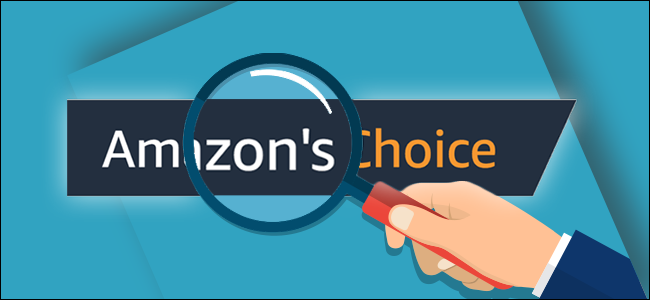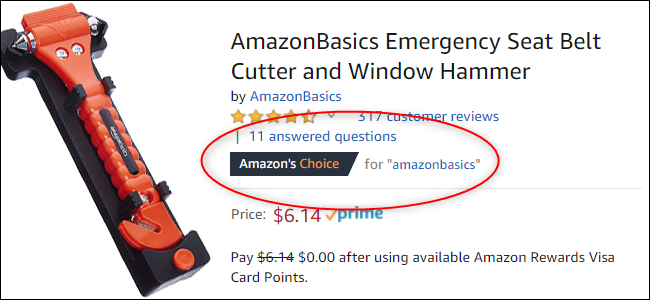Quick Links
Amazon's Choice is a fantastic little program, and it's probably informed a handful of your purchases. But have you ever stopped to ask who chooses Amazon's Choice, or how the program works behind the scenes?
Amazon's Choice is a Byproduct of Alexa
As a whole, Amazon is successful because it makes shopping easy. It's hard to complain about free one-day shipping, low prices, easy returns, and the largest retail selection on earth. But Amazon has a seemingly unfixable problem: there are too many products on its marketplace.
While most retailers sell their products directly to customers, Amazon relies on an open market system with a ton of 3rd-party sellers. Anyone can sell items on the Amazon marketplace, and these 3rd-party sellers are responsible for half of Amazon's sales according to Jeff Bezos. As you've probably guessed, this system works well for Amazon and its customers. Open markets create competition, which leads to lower prices, better service, and a wide selection of items to choose from.
A wide retail selection is usually a good thing. But what happens when you need to buy something cheap and ubiquitous, like a USB-B cable? Well, you'd better know what you're looking for. Among Amazon's 400+ search results for the term "USB-B" cable are a ton of weird options and technically incorrect results. This ultra-convoluted selection is manageable (albeit annoying) on a computer or perhaps even a phone, which is why Amazon didn't do anything about it until 2015 when Alexa launched.
Whenever Amazon rolls out a big new product, you can expect it to have access to the Amazon marketplace. You can shop for books through a Kindle, buy apps on a Kindle Fire, and rent movies through Fire TV. You can shop just by talking to Alexa, too.
Here's the problem: Alexa is meant to make life easier, but shopping for socks and toothpaste with your voice is a nightmare. To fix the problem, Amazon decided that you should only be able to buy specific, popular items through the Alexa interface. These items were dubbed "Amazon's Choice," and the label was extended to the Amazon website to make it easier to shop from your computer.
Amazon Won't Say Who Chooses Amazon's Choice
The purpose of Amazon's Choice is pretty clear, but how do products get the Choice label? According to Alexa, the Choice label is awarded to "highly rated, well-priced products available to ship immediately." Sure, anyone could've guessed that but who chooses which products are marked as Amazon's Choice? Is it done through an algorithm, or are Amazon employees involved? Can a company pay for its product to be listed as Amazon's Choice?
Long story short, nobody knows who chooses Amazon's Choice, not even the Amazon sellers that are awarded the Choice badge. We asked a representative from Amazon for more information, and she reiterated Alexa's claim that Amazon's Choice "launched in 2015 as a way to simplify shopping for customers by highlighting highly rated, well-priced products ready to ship immediately." Good to know. She also clarified that "companies cannot pay to have their product listed as Amazon's Choice" but didn't tell us if Choice is fully algorithmic or if there are people involved.
Now, if you've gone half a decade assuming that Amazon's Choice products are vetted by actual human beings, this conversation can be a little frustrating. The name "Amazon's Choice" suggests that real humans are picking out products for you, and it's possible that Amazon is tight-lipped about the program's workings because it's entirely run by robots. But Amazon is probably just protecting the integrity of the Choice system. Amazon's algorithms are routinely manipulated by sellers, and the Choice program could be compromised if its inner-workings go public.
Until Amazon releases more details about Amazon's Choice, it's impossible to know how products receive the Choice label. But you can learn a lot about the program by simply poking around the Amazon marketplace.
Amazon's Choice Depends on Your Search Terms
Have you ever noticed the Amazon's Choice label will only show up on one product at a time? Marking multiple items as Choice would ultimately defeat the purpose of the program, and it would make shopping through Alexa more difficult. But how does Amazon decide which product to show as Amazon's Choice? Well, it depends on your search terms.
Each Amazon's Choice product is linked to a specific search term, and you can check that search term by hovering over a product's Amazon's Choice label. As it turns out, a product's Choice label will only show up if you perform a search for its specific search term. As an example, the Amazon's Choice for "dish shop" is a lemon-scented Meyer's clean day dish soap. But if you look up "Meyer's dish soap," the lemon-scented soap loses its Choice label. Similarly, the current Amazon's Choice item for the search term "guitar" is a YMC acoustic guitar, but the Choice for the search term "acoustic guitar" is a Jameson acoustic guitar.
Interestingly enough, broad search terms will sometimes give you weird Choice results. If you search "amazonbasics," the Choice item is a seatbelt cutter. This isn't the kind of situation where a Choice label is useful, which suggests that it may have been applied by an algorithm. That being said, any attempt to figure out the Amazon's Choice system is just speculation.
While this system is super specific, it's also surprisingly simple. You'd think that Amazon's Choice items would cater to a user's buying history (people that buy natural mouthwash probably want natural toothpaste), but they're actually the same for every user. Not to mention, a user's location doesn't change which Choice items they see. Yes, you'll see different Choice items for "soap" on the Italian or UK Amazon websites, but your IP address or location data has nothing to do with the Choice items that you see. It's all in the search terms.
Amazon Items Tend to be Amazon's Choice
Nobody knows how Choice items receive their label, but you can usually predict which item will have the Choice label before you perform a search. Just ask yourself, "does Amazon sell one of these?"
You've probably noticed this by now, but Amazon-branded items tend to have an Amazon's Choice label. Look up "batteries," and the Choice is AmazonBasics batteries. For "micro USB," it's an AmazonBasics USB cable. For "streaming stick," it's a Fire TV stick. Amazon's Choice for the search term "tablet" is, naturally, a Fire tablet.
Is this Amazon's way of getting the upper hand in new markets? Probably not. The AmazonBasics seatbelt cutter is cheaper than any other seatbelt cutter on Amazon, as is the AmazonBasics HDMI cable. Since the Choice label is dedicated to "highly rated, well-priced products available to ship immediately," it makes sense to slap the Choice labels on AmazonBasics products.
But on the flipside, Amazon's competitors rarely receive the Amazon's Choice label for their products. This situation is impossible to explain, but it's also hard to overlook. You'd think that iconic and specific products like the iPad Pro would have Choice labels, but if you search for the iPad Pro on Amazon, none of the product listings have an Amazon's Choice label. The same goes for the AirPods, the iPhone X, and the Apple TV. To Amazon's credit, the Apple Watch is Amazon's Choice for the search term "Apple Watch," and the iPad Air is Amazon's Choice for the oddly specific yet laughably incorrect search term "iPad Pro 10.5."
Apple's clearly getting the short end of the stick, but Google has it worse. The company has never had a good relationship with Amazon, and only about 20 official Google products are sold on the Amazon marketplace (some of those products are routinely taken down). If you're wondering how many Google products are listed as Amazon's Choice, the answer is a resounding zero. You'd assume that ultra-specific products like the Pixelbook, the Chromecast, or the Google Wi-Fi (Amazon's bestselling mesh Wi-Fi router) would have an Amazon's Choice label, but hey, they don't.
So, Who Chooses Amazon's Choice?
Again, it's impossible for us to know how products get the Choice label. It's fair to assume that most (if not all) of the work is done automatically, notably when some products, like the AmazonBasics seatbelt cutter, are awarded Choice badges for broad or useless search terms. On the other hand, the exclusion of competitor's products from the Amazon's Choice program suggests that Amazon can manually decide which items receive the label.
Amazon won't confirm or deny anything, so all anyone can offer is speculation. While it's easy to assume that the company is hiding something, it's probably just protecting the integrity of the Amazon's Choice system. Amazon's sorting algorithms are continually being manipulated by sellers, and the Choice program could be compromised in the same way.
It's also possible that Amazon is tight-lipped in an attempt to avoid controversy. The thing is, regardless of how the Amazon's Choice system works, people are going to be upset with it. If it's manually curated, sellers will accuse Amazon of giving an unfair advantage to specific businesses. If the program is fully automated, customers will complain that the name "Amazon's Choice" is misleading.
Either way, the Amazon's Choice system seems to be working well for everyone (minus Apple and Google). Customers can find cheap, reliable products, and sellers have more incentive to lower costs and increase customer satisfaction.




